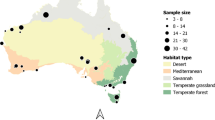Abstract
Owl pellets, regurgitates formed by the undigested parts of owls’ prey, have been used since the 1960s to estimate relative species abundances and community diversity of small mammals in the field. Although insects are important food sources for raptors, the usefulness of owl pellets as a collecting method for entomological studies remains practically unexplored. Many terrestrial arthropods have fragile bodies that degrade during the raptor’s digestive process; however, darkling beetles (Tenebrionidae) resist this process. These organisms are abundant and rich in species, and play significant roles in food and nutrient soil cycles in arid regions. Moreover, darkling beetles are well known and represent up to 52% of prey abundances in Bubo magellanicus (Lesson), one of the most common owls in arid Patagonia. The aim of this work is to evaluate the suitability of B. magellanicus pellets as a research tool for studies of tenebrionid beetle biodiversity assessments in arid Patagonia. Thus, we compare tenebrionid relative species abundances, species richness, and their species assemblage estimated from the diet of B. magellanicus with those identified simultaneously by conventional trapping (pitfall trapping and hand collecting) using multivariate techniques and the Fisher’s exact test. Mitragenius araneiformis Curtis, Patagonogenius quadricollis Fairmaire, and Emmallodera crenaticostata crenaticostata Blanchard were the most abundant tenebrionid species. Relative abundances of almost all species, the estimation of species richness, and tenebrionid assemblage from both collecting methodologies were similar. Therefore, we propose the owl pellet analysis as a useful sampling tool for rapid estimations of the tenebrionid assemblage structure in arid Patagonia.




Similar content being viewed by others
References
Andrade A, Nabte MJ, Kun ME (2010) Diet of the burrowing owl (Athene cunicularia) and its seasonal variation in Patagonian steppes: implications for biodiversity assessments in the Somuncurá Plateau Protected Area, Argentina. Stud Neotrop Fauna E 45:101–110. https://doi.org/10.1080/01650521.2010.502010
Andrade A, Saraiva de Menezes JF, Monjeau A (2016) Are owl pellets good estimators of prey abundance? JKSUS 28:239–244. https://doi.org/10.1016/j.jksus.2015.10.007
Andrews P (1990) Owls, caves, and fossils: predation, preservation, and accumulation of small mammal bones in caves, with an analysis of the Pleistocene cave faunas from Westbury-sub-Mendip, Somerset, UK. University of Chicago Press, Chicago, p 231
Baldi R, Cheli G, Udrizar Sauthier DE, Gatto A, Pazos GE, Avila LJ (2017) Animal diversity, distribution and conservation. In: Bouza P, Bilmes A (eds) Late Cenozoic of Península Valdés, Patagonia, Argentina. Springer International Publishing, Cham, pp 263–303
Bellocq MI (2000) A review of the trophic ecology of the barn owl in Argentina. J Raptor Res 34:108–119
Borcard D, Gillet F, Legendre P (2011) Numerical ecology with R. Springer New York, New York, NY, p 319
Bouchard P, Bousquet Y, Davies A, Alonso-Zarazaga M, Lawrence J, Lyal C, Newton A, Reid C, Schmitt M, Slipinski A, Smith A (2011) Family-group names in Coleoptera (Insecta). ZooKeys 88:1–972. https://doi.org/10.3897/zookeys.88.807
Carrara R, Cheli GH, Flores GE (2011) Patrones biogeográficos de los tenebriónidos epigeos (Coleoptera: Tenebrionidae) del Área Natural Protegida Península Valdés, Argentina: implicaciones para su conservación. Rev Mex Biodivers 82:1297–1310
Carrara R, Flores GE (2013) Endemic tenebrionids (Coleoptera: Tenebrionidae) from the Patagonian steppe: a preliminary identification of areas of micro-endemism and richness hotspots. Entomol Sci 16:100–111. https://doi.org/10.1111/j.1479-8298.2012.00542.x
Chao A, Gotelli NJ, Hsieh TC, Sander EL, Ma KH, Colwell RK, Ellison AM (2014) Rarefaction and extrapolation with Hill numbers: a framework for sampling and estimation in species diversity studies. Ecol Monogr 84:45–67. https://doi.org/10.1890/13-0133.1
Cheli GH, Corley JC (2010) Efficient sampling of ground-dwelling arthropods using pitfall traps in arid steppes. Neotrop Entomol 39:912–917
Cheli GH, Corley J, Bruzzone O, Del Brío M, Martínez F, Martínez Román N, Ríos I (2010) The ground-dwelling arthropods community from Península Valdés (Patagonia, Argentina). J Insect Sci 10:1–16
Cheli GH, Flores G, Martínez Román N, Podestá D, Mazzanti R, Miyashiro L (2013) A tenebrionid beetle’s dataset (Coleoptera, Tenebrionidae) from Peninsula Valdés (Chubut, Argentina). ZooKeys 364:93–108. https://doi.org/10.3897/zookeys.364.4761
Cheli GH, Martínez FJ (2017) Artrópodos terrestres, su rol como indicadores ambientales. In: Udrizar Sauthier DE, Pazos GE, Arias AM (eds) Reserva de Vida Silvestre San Pablo de Valdés: 10 años protegiendo el patrimonio natural y cultural de la Península Valdés. Fundación Vida Silvestre Argentina & CONICET, Buenos Aires, Argentina, pp 98–117
Cheli GH, Martínez FJ, Pazos G, Udrizar Sauthier D, Coronato F, Flores GE (2016) Epigean Tenebrionids (Coleoptera: Tenebrionidae) from Leones and Tova-Tovita Islands (Chubut, Argentina) and its comparison with the mainland assemblage. Ann Zool 66:631–642. https://doi.org/10.3161/00034541ANZ2016.66.4.015
Clarke KR, Warwick RM (2001) Change in marine communities: an approach to statistical analysis and interpretation. PRIMER-E, Plymouth, p 91
Colwell RK, Chao A, Gotelli NJ, Lin S, Mao Ch X, Chazdon RL, Longino JT (2012) Models and estimators linking individual-based and sample-based rarefaction, extrapolation and comparison of assemblages. J Plant Ecol 5:3–21. https://doi.org/10.1093/jpe/rtr044
Crawford CS (1988) Nutrition and habitat selection in desert detritivores. J Arid Env 14:111–121
Cruz-Jofré F, Vilina YA (2014) Ecología trófica de Athene cunicularia (Aves: Strigidae) en un sistema insular del norte de Chile: ¿posible respuesta funcional y numérica frente a Pelecanoides garnotii (Aves: Pelecanoididae)? Gayana 78:31–40. https://doi.org/10.4067/S0717-65382014000100005
Fattorini S, Manganaro A, Salvati L (2001) Insect identification in pellets analysis: implications for the foraging behaviour of raptors. Buteo 12:61–66
Flores GE (1998) Tenebrionidae. In: Morrone JJ, Coscarón S (eds) Biodiversidad de artrópodos argentinos: una perspectiva biotaxonómica. Editorial Sur, La plata. Buenos Aires:232–240
Flores GE (1999) Systematic revision and cladistic analysis of the Neotropical genera Mitragenius Solier, Auladera Solier and Patagonogenius gen. n. (Coleoptera: Tenebrionidae). Entomol Scand 30:361–396
Flores GE (2004) Systematic revision and cladistic analysis of the Patagonian genus Platesthes (Coleoptera: Tenebrionidae). Eur J Entomol 101:591–608. https://doi.org/10.14411/eje.2004.083
Flores GE, Carrara R, Cheli GH (2011) Three new Praociini (Coleoptera: Tenebrionidae) from Penísula Valdés (Argentina), with zoogeographical and ecological remarks. Zootaxa 2965:39–50
Flores GE, Cheli GH (2014) Two new species of Nyctelia Latreille (Coleoptera: Tenebrionidae) from Argentinean Patagonia with zoogeographical and ecological remarks. Zootaxa 3765:279. https://doi.org/10.11646/zootaxa.3765.3.4
Formoso AE, Teta P, Cheli GH (2012) Food habits of the Magellanic horned owl (Bubo virginianus magellanicus) at southernmost Patagonia, Argentina. J Raptor Res 46:401–406
Formoso AE, Teta P, Carbajo A, Pardiñas U (2016) Unravelling the patterns of small mammals species richness in the southernmost aridlands of South America. J Arid Environ 134:136–144
Grayson DK (1973) On the methodology of faunal analysis. Am Antiq 38:432–439. https://doi.org/10.2307/279149
Hanney P (1963) Observations upon the food of the barn owl (Tyto alba) in southern Nyasaland, with a method of ascertaining population dynamics of rodent prey. Ann Mag Nat Hist 6:305–313. https://doi.org/10.1080/00222936308651360
Heisler LM, Somers CM, Poulin RG (2016) Owl pellets: a more effective alternative to conventional trapping for broad-scale studies of small mammal communities. Methods Ecol Evol 7:96–103. https://doi.org/10.1111/2041-210X.12454
Hernández J (2016) Hábitos alimenticios de rapaces nocturnas en zonas con intensa actividad hidrocarburífera. Honors Thesis, Facultad de Ciencias del Ambiente y la Salud, Universidad Nacional del Comahue, Bariloche, p 50
Hsieh TC, Ma KH, Chao A (2013) iNEXT online: interpolation and extrapolation (Version 1.0) [Software]. <http://chao.stat.nthu.edu.tw/blog/software-download/>. Accessed 31 Aug 2015
Jaksic FM (1981) Abuse and misuse of the term “guild” in ecological studies. Oikos 37:397. https://doi.org/10.2307/3544138
Kulzer H (1955) Monographie der Scotobiini (Zehnter Beitrag zur Kenntnis der Tenebrioniden). Ent Arb Mus G Frey 6:383–478
Kulzer H (1958) Monographie der südamerikanischen Tribus Praocini (Col.) (16 Beitrag zur Kenntnis der Tenebrioniden). Ent Arb Mus G Frey 6:383–478
Kuschel G (1969) Biogeography and ecology of South American Coleoptera. In Fittkau EJ, Illies J, Klinge H, Schwabe GH, Sioli H (Eds.) Biogeography and ecology in South America. Vol. 2. Jung. La Haya, Holand, pp 709–722
Legendre P, Legendre L (2012) Numerical ecology, third English edition. Elsevier, Amsterdam, p 1006
Marone LB, Jaksic FA (2013) Ecología de comunidades. e-book. 2nd ed. Publisher: Universidad Catolica de Chile, Santiago, p 336
McDonald JH (2014) Handbook of biological statistics, 3rd edn. Sparky House Publishing, Baltimore, Maryland, p 296
Nabte MJ, Saba SL, Pardiñas UFJ (2006) Dieta del Búho Magallánico (Bubo magellanicus) en el desierto del monte y la Patagonia Argentina. Ornitol Neotrop 17:27–38
Oksanen J (2018) Multivariate analysis of ecological communities in R: Vegan tutorial. <https://cran.r-project.org/web/packages/vegan/vegan.pdf>. Accessed 25 Oct 2018
Pardiñas UFJ, Udrizar Sauthier DE, Teta P (2012) Micromammal diversity loss in central-eastern Patagonia over the last 400 years. J Arid Environ 85:71–75
R Development Core Team (2017) R: a language and environment for statistical computing, Vienna: R Foundation for Statistical Computing, http://www.R-project.org
Schowalter TD (2016) Insect ecology: an ecosystem approach, 4th edn. Elsevier Academic Press, San Diego, p 762
Sklodowski J, Gryz J (2012) Insects in the diet of the tawny owl (Strix aluco) in forest areas of central and north−eastern Poland. Sylwan 156:36–46
Solaro C, Santillán MA, Costán AS, Reyes MM (2012) Ecología trófica de Athene cunicularia y Tyto alba en el cerro Curru-Mahuida, ecotono Monte–Espinal, La Pampa, Argentina. Hornero 27:177–182
Triplehorn CA, Johnson NF, Borror DJ (2005) An introduction to the study of insects, 7th edn. Thomson, Brooks/Cole, Australia, p 864
Trejo A, Grigera D (1998) Food habits of the great horned owl (Bubo virginianus) in a Patagonian steppe in Argentina. J Raptor Res 32:306–311
Trejo A, Kun M, Sahores M, Seijas S (2005) Diet overlap and prey size of two owls in the forest-steppe ecotone of southern Argentina. Ornitol Neotrop 16:539–546
Udrizar Sauthier DE, Formoso AE, Cheli GH, Pazos GE (2017) Food habits of the Magellanic horned owl (Bubo magellanicus) in a coastal island of Patagonia, Argentina. Ornitol Neotrop 28:237–241
Acknowledgments
We are grateful to rangers and employees of Administración de Parques Nacionales (G. Solveira, R. Amado, A. Serra, D. Fernández, A. Beati, O. Martínez, S. Rusak, and C. Chehebar) for their help with field work and collecting permissions; Prefectura Naval Argentina, Secretaría de Turismo y Áreas Naturales Protegidas (J. Tolosano and V. Fratto) for providing collecting permissions. We thank deeply IPEEC CCT CENPAT - CONICET and its staff for providing facilities and logistic support; Municipalidad de Camarones for accommodation and facilities for lecturing activities; and NGO Planete Urgence, S. Sorroche, G. Pazos, and F. Coronato for their help in the field work. We thank Alejandra Bueno for her language assistance and two anonymous reviewers for their valuable comments that improved the manuscript. Field work was supported by the government of the Chubut Province (Instituto Provincial de Investigaciones de los Recursos del Mar de la provincia del Chubut), Agencia Nacional de Promoción Científica y Tecnológica (PICT 2012-2660), CONICET (PUE-IPEEC-CONICET No. 22920160100044) and the International Barcode of Life Project (iBOL).
Author information
Authors and Affiliations
Contributions
GCH, DU, and FM planned, designed, and executed field work; GF and GCH made the taxa identification; GCH and FM analyzed the data; GCH, DU, GF, and FM wrote the manuscript.
Corresponding author
Additional information
Edited by Edison Ryoiti Sujii – Embrapa/CENARGEN
Publisher’s Note
Springer Nature remains neutral with regard to jurisdictional claims in published maps and institutional affiliations.
Rights and permissions
About this article
Cite this article
Cheli, G.H., Udrizar Sauthier, D.E., Martínez, F.J. et al. Owl Pellets, a Useful Method to Study Epigean Tenebrionid Beetles in Arid Lands. Neotrop Entomol 48, 748–756 (2019). https://doi.org/10.1007/s13744-019-00692-7
Received:
Accepted:
Published:
Issue Date:
DOI: https://doi.org/10.1007/s13744-019-00692-7




